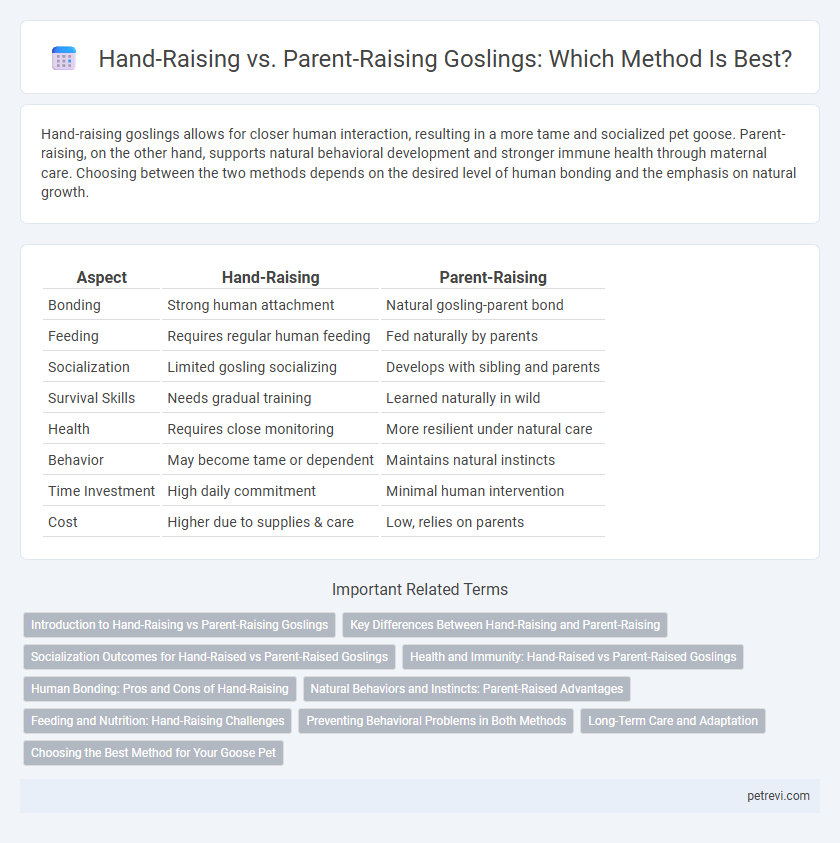Hand-raising goslings allows for closer human interaction, resulting in a more tame and socialized pet goose. Parent-raising, on the other hand, supports natural behavioral development and stronger immune health through maternal care. Choosing between the two methods depends on the desired level of human bonding and the emphasis on natural growth.
Table of Comparison
| Aspect | Hand-Raising | Parent-Raising |
|---|---|---|
| Bonding | Strong human attachment | Natural gosling-parent bond |
| Feeding | Requires regular human feeding | Fed naturally by parents |
| Socialization | Limited gosling socializing | Develops with sibling and parents |
| Survival Skills | Needs gradual training | Learned naturally in wild |
| Health | Requires close monitoring | More resilient under natural care |
| Behavior | May become tame or dependent | Maintains natural instincts |
| Time Investment | High daily commitment | Minimal human intervention |
| Cost | Higher due to supplies & care | Low, relies on parents |
Introduction to Hand-Raising vs Parent-Raising Goslings
Hand-raising goslings involves direct human care from hatching, ensuring consistent feeding, warmth, and socialization, which can lead to strong bonding with humans. Parent-raising allows goslings to learn natural behaviors and develop survival skills under the guidance of adult geese, promoting independence and species-specific social structures. Choosing between methods depends on goals such as tameness, conservation efforts, or natural development.
Key Differences Between Hand-Raising and Parent-Raising
Hand-raising goslings involves direct human intervention, providing controlled feeding schedules and socialization, which often leads to imprinting on humans and can affect their natural behaviors. Parent-raising allows goslings to learn essential survival skills and social cues from their own species, promoting natural development and stronger instincts for foraging and predator awareness. The primary difference lies in the level of human interaction, with hand-raising fostering dependency and parent-raising encouraging independence and natural growth.
Socialization Outcomes for Hand-Raised vs Parent-Raised Goslings
Hand-raised goslings often develop stronger bonds with humans but may struggle with species-specific social cues, potentially leading to behavioral issues in interactions with other geese. Parent-raised goslings typically acquire natural social behaviors and flock integration skills essential for their survival and reproduction. Studies show that hand-raising can result in increased tameness, while parent-raising promotes more effective socialization within goose communities.
Health and Immunity: Hand-Raised vs Parent-Raised Goslings
Hand-raised goslings often receive controlled diets and medical care that can enhance early health monitoring but may lack exposure to natural pathogens essential for developing robust immunity. Parent-raised goslings benefit from natural maternal antibodies and environmental interactions that strengthen immune system resilience against diseases. Studies reveal that goslings reared by parents generally exhibit stronger long-term immunity, though hand-raising permits tailored health interventions in critical growth phases.
Human Bonding: Pros and Cons of Hand-Raising
Hand-raising goslings fosters strong human bonding, making them more socialized and easier to handle, which benefits caretakers seeking interactive pets or educational animals. However, this method can reduce goslings' natural survival instincts and lead to greater dependency on humans, potentially impacting their ability to thrive in natural or mixed environments. Parent-raised goslings develop essential self-sufficiency and natural behaviors, but lack the close human bond seen in hand-raised counterparts, which may result in more skittish or independent animals.
Natural Behaviors and Instincts: Parent-Raised Advantages
Parent-raised goslings develop stronger natural behaviors and instincts essential for survival, such as effective foraging, predator avoidance, and social interaction within the flock. The presence of adult geese provides constant guidance, reinforcing species-specific communication and bonding patterns that are less evident in hand-raised goslings. These advantages contribute significantly to the overall health, adaptability, and successful integration of goslings into wild or semi-wild environments.
Feeding and Nutrition: Hand-Raising Challenges
Hand-raising goslings requires precise control over feeding schedules and balanced nutrition, as improper diet can lead to developmental issues like leg deformities and weak immune systems. Parent-raised goslings benefit from natural feeding patterns and nutrient intake through their mother's guidance, ensuring optimal growth and health. Hand-raisers must carefully replicate the nutrient composition of natural gosling diets to prevent malnutrition and support healthy growth stages.
Preventing Behavioral Problems in Both Methods
Hand-raising goslings requires consistent human interaction to prevent imprinting issues and promote socialization skills, reducing aggression and fearfulness. Parent-raised goslings naturally learn species-specific behaviors, which helps in developing normal social hierarchies and reduces stress-induced behavioral problems. Both methods benefit from early environmental enrichment to encourage healthy development and prevent stereotypic behaviors.
Long-Term Care and Adaptation
Hand-raising goslings often results in stronger human imprinting, which can impact their long-term social behavior and reduce their ability to integrate with wild flocks. Parent-raised goslings typically develop natural foraging skills and social adaptations essential for survival and reproduction in diverse environments. Long-term care of hand-raised geese requires ongoing human interaction to compensate for potential deficits in innate behaviors and environmental adaptability.
Choosing the Best Method for Your Goose Pet
Hand-raising goslings ensures close human interaction and socialization, promoting trust and tameness ideal for pet geese, while parent-raising allows natural development of instincts and behaviors essential for survival skills. Assess the environment, your time commitment, and your goal for the goose's temperament to decide the best approach. Prioritize consistent care, proper nutrition, and socialization to foster a healthy, well-adjusted pet goose regardless of the chosen method.
Hand-raising vs Parent-raising for Goslings Infographic

 petrevi.com
petrevi.com